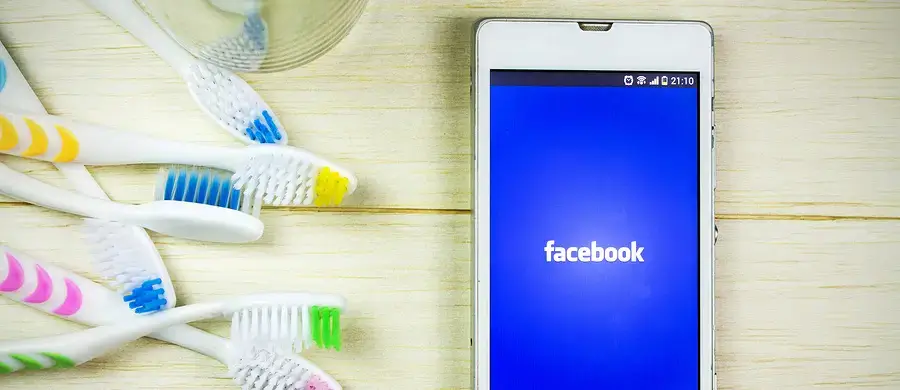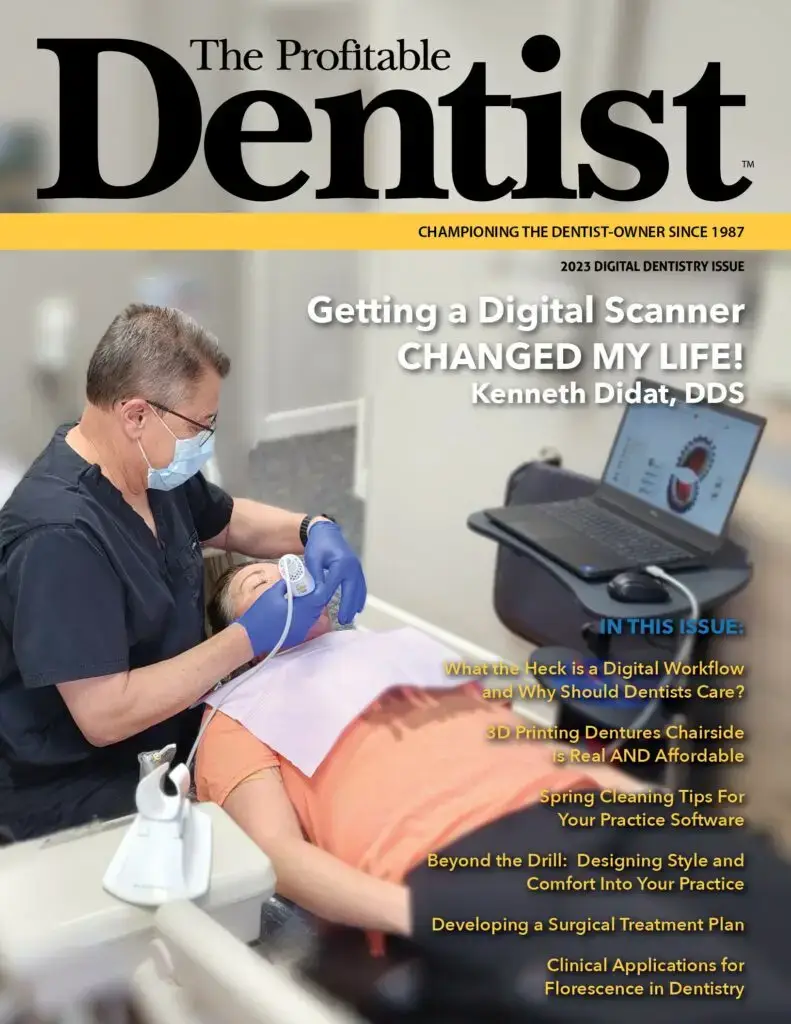In today’s ever-competitive world, Dentists find themselves in a struggle to follow their ideals and ethics in practice. We want to hire the best staff, have the latest and greatest equipment and technology, hone our skills through CE courses to be at the top of our clinical game and of course, have a following of patients that appreciate the highest level of care and are willing to pay for it.
Those ideals are insurmountable for most Dentists. Established Dentists find that reliance on old ways of running a practice, failure to keep up with technology and maintain quality staff, and competition from offices that accept reduced fees from panel memberships with PPOs have cut into their busyness. Newer practitioners, saddled with debt from college and dental school are forced to seek employment as associate Dentists where they live the dream of others, not their own.
It’s hard to put a finger on how this transformation has occurred but I have seen it take hold before my eyes in the last 30 years. I escaped the trap by focusing on care for phobic individuals and by perfecting skills in that area. I stayed ahead of the curve with technology and hired great staff and paid them well, resulting in continuity of care and staff, all factors that help weather the challenge of lower priced competitors. Ultimately, the breakdown in the system comes when patients are not made aware of the quality of the product or service offered. We get so wrapped up in meeting production goals and focusing on efficiency that we often lose the human touch, delegating many services to the least qualified individual who can satisfactorily deliver a service and often, automating and virtualizing tasks, completely eliminating personal interactions. When patients perceive our offering as something they can obtain anywhere at a similar level of quality and competency, then going to the Dentist does not become much different than buying a new appliance, and the decision is made based on cost and convenience.
Every now and then something comes along in our profession that provides an opportunity to change all this, to demonstrate our care and concerns for our patients as people, not just mouths of teeth and gums, and to relate that our office is on the cutting edge with the latest advances in care, medically and technologically. I believe such an opportunity is on our doorstep right now and not a single one of us can afford to miss this. Early adopters will gain respect from their patients and enjoy the opportunity to show the value of being a patient of the practice and at the same time provide us with unlimited potential for economic success while doing the best thing we can for our patients’ overall health. Exactly what is this amazing opportunity I am referring to? About a year ago I got introduced to the team at Keystone Bio and discovered the amazing work they are doing to eradicate Porphyromonas Gingivalis, also known as P.Gingivalis, or for simplicity, PG. Being 40+ years removed from Microbiology in Dental School, I needed to do quite a lot of reading in the follow up to that intro to become savvy on the topic. The bacteria itself has been the subject of research in thousands of articles for over 50 years, yet most Dentists know very little about this highly evolved and pathogenic, anaerobic bacteria that thrives subgingivally in the biofilm primarily of those with Periodontal Disease. It wasn’t until early in the 21st Century that Hajishengallis and Darveau1 used the term “Keystone Pathogen” to describe the role of PG in periodontal disease. Over the years, PG has been implicated in a wide number of orally originating systemic diseases including, but not limited to, Alzheimer’s Disease, atherosclerotic diseases including hypertension, strokes and myocardial infarctions, digestive cancers (esophageal, pancreatic, colorectal, oral), Cardio-Metabolic Diseases including Diabetes, Rheumatoid arthritis and a long list of others. In virtually 100% of autopsied brains of individuals afflicted with Alzheimer’s Disease the toxic proteins of PG have been identified. Early researchers were thwarted in their attempts to find the bacteria itself in the end organs in these disease processes which has contributed to the slow understanding of the process of this oral-systemic connection and has resulted in a general failure of the public to perceive the dangers of gum disease as it relates to their overall body health. Dentists have been preaching to them about the O-S connection, but without an understanding of the process that information goes the proverbially in one ear and out the other, attesting to the fact that most patients are not compliant with recommended periodontal therapy or necessary follow up care. The team at Keystone Bio (so named for their work with the Keystone Pathogen of periodontal disease) has unearthed the pathway for destruction caused by PG infection in the gums. This highly evolved bacteria developed chemical pathways to avoid detection by our immune system, thus allowing it to exist relatively unencumbered by the normal immune response to infection. The organism itself secretes outer membrane vesicles (OMVs) which are loaded with toxic proteins. These toxic proteins, called Gingipains, are released into the bloodstream and taken away by the body from the initial source of infection, the gums, to multiple organs of the body where these proteins do the dirty work of the bacteria. Most bacteria do not have the ability to cross the blood brain barrier (BBB) an evolutionary development which protects our brains, spinal cord and nervous system from infection. A few, like meningococcus, can cross the BBB giving meningitis the ability to swiftly cause serious infection and death. PG cannot cross the BBB so researchers looking for it in autopsied brains have been stymied. Even if it could cross the barrier, as an anaerobe, it strongly prefers areas of low oxygen tension and the brain has the highest oxygen tension of any organ in the body. The team at Keystone Bio discovered that the OMVs of PG increase permeability of the BBB and can cross it, carrying the toxic proteins of PG into the brain, where they disrupt neuronal transmission and promote the symptoms of dementia as well as the formation of beta-amyloid plaques in the brain, long recognized as pathognomonic for Alzheimer’s Disease. Indeed, this pathway was the lead article featured in the August 17, 2021 “Journal of Alzheimer’s Disease,” authored by the team at Keystone Bio.2 Drugs in the past that have attempted to lessen the symptoms and severity of Alzheimer’s Disease have mostly focused on breaking down these plaques, but most patients at that stage are too late in the progression to have a positive effect. One company, Cortexyme, working on the hypothesis that PG did cross the BBB, pioneered a medication that attacked a single toxic protein of PG. Unfortunately, there are 151 toxic proteins of PG identified to date. Their study was delayed as the trials were put on hold by the FDA due to liver toxicity and ultimately the results were extremely disappointing, resulting in a drop in their stock price of over 90%. However, examination of a large subset of their trial population, those with periodontal disease with PG infection, demonstrated a reversal of symptoms or at least a halting of the progression of symptoms in those patients, an extremely positive finding for the team at Keystone Bio. Since Keystone Bio’s biologic formulation, a monoclonal antibody, attacks the bacteria at the source and eradicates it from the pocket for an estimated nine months to a year in most individuals, the need to attack the toxic proteins is removed since we are preventing their release by eliminating the organism responsible for producing it.
The most exciting part of all this is that the therapy will be performed by Oral Healthcare Professionals, namely Dentists and Hygienists. Currently, when an individual with PG infected periodontal disease presents for a routine prophylaxis, which by definition, does not remove the subgingival biofilm, a reduction in the PG population may be achieved initially but within 7-10 days the population of PG and the biofilm returns to pre-prophylactic levels. The results are slightly better when patients with this infection receive thorough debridement subgingivally, either with meticulous periodontal maintenance procedures or deep scaling and root planing, as in these patients, levels of PG and the biofilm do not return to pre-treatment levels for 3-4 weeks. It’s noteworthy that even though scaling temporarily reduces levels of PG, the flow of the toxic proteins throughout the body are never stopped. By administering the drug, call it KB-001 for now, simply placed along the gumline with a blunt irrigation needle into the pockets after therapeutic treatment, we will be able to eliminate PG from returning before 9 months, and repetition of the treatment at six-month intervals can prevent PG from ever returning to do damage. Imagine the increase in visits, increase in prestige of Dentists as the primary care provider for the prevention of serious diseases, and increase in income for Dentists from this new therapy. Anticipated cost to the patient for this treatment would be in the neighborhood of $500 in addition to current therapy performed simultaneously. As medical insurance providers also stand to be big winners here, with reduction in costs for patients with heart disease, Alzheimer’s Disease, Diabetes, etc. expect this service to be reimbursable through the patient’s medical insurance provider.
One of the obstacles we face in gaining acceptance of this new therapy, which we hope will be available in two to three years, is creating patient awareness of the problem. When I first heard about all this a bit over a year ago, I ran a quick yes or no poll on my Facebook Profile. I simply asked my non-Dentist friends if they had ever heard of P.Gingivalis. I got 74/75 “no” answers, and the one yes I did receive came from a friend who figured out the meaning from the Latin derivation of the word but had not actually heard of it. We need, as a profession, to create a public awareness of this evil bacteria. 50% of adults over age 30 have some form of periodontal disease. Over age 65 that number is a staggering 80% and over half of adults have PG present in their oral flora. For a start, we can help our patients find out if they have PG with a simple salivary test of the likes offered by several companies direct to the public. We can even show them how their levels are PG are high right before treatment, lowered by treatment, then return to high levels as they get further away from their last treatment. Through this awareness that we can create, we will have developed a legion of patients who understand the oral-systemic connection better, will accept our current periodontal treatment recommendations more often, will return for their recommended treatment intervals more regularly, and will anticipate the availability of this new treatment protocol once it gains approval and is market ready. It’s a double win for Dental Offices, better treatment acceptance now, and enhanced demand and acceptance for the new treatment when it becomes available.
There are two obvious ways to perform this awareness campaign. Direct discussion with each patient is possible but is tedious and time consuming. Printed brochures are helpful but typically don’t get a lot of eyeballs on them and post pandemic we have been taking steps to reduce or eliminate reception area wait time, thereby reducing the effectiveness of reception area reading materials. The most practical and efficient method is with social media. I developed this series of posts for a client of mine, a Periodontist in Florida, as a takeoff on Samuel Jackson’s Capital One commercials where he asks “What’s in your wallet?” We ask our patients if they know “What’s in your mouth,” thereby creating awareness of the bacterial nature of the disease and introducing them to the known bad bugs, including PG:
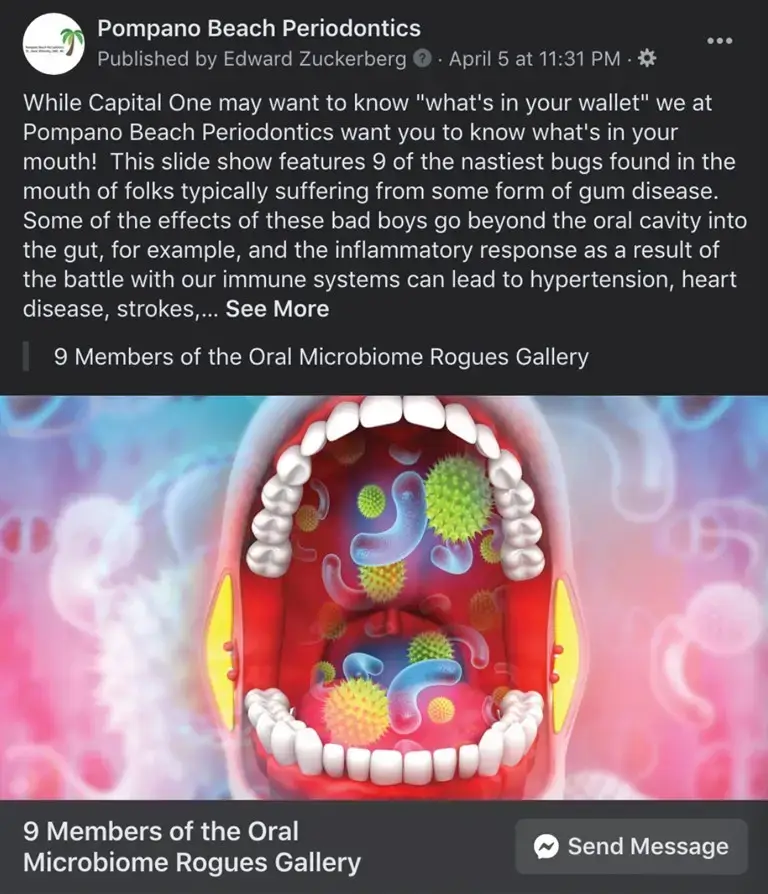
Measuring click rate showed us that many folks had enough interest in this content to follow through by clicking the link to read the article. Through analytics we can also measure those messages we received on Facebook as a result of clicking the “send message” button in the post and were able to identify at least 5 conversations started as a result of this post. We followed up this successful post with a daily post highlighting a new “bug of the day” leading up to the PG post:
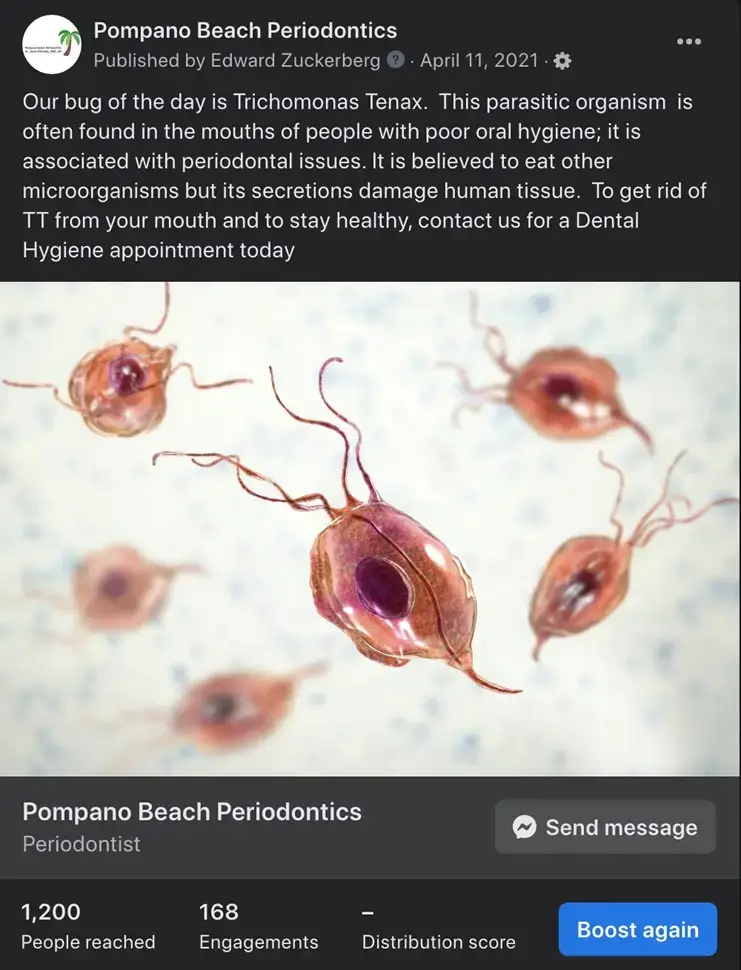
Note that we also boosted this post resulting in a twelve-fold gain in reach vs similar non-boosted posts. We spent $35 on this campaign and ran the campaign for one week. When we finally got to the PG post, we brought in the direct connection to end organ diseases and the oral-systemic connection. We have periodically recycled the same post and used different distribution routes. Boosting allows us to target existing fans of the Page which gets us greater penetration to our existing base for the post vs. organic non-boosted posts. Another favorite targeting campaign we use is to target to friends of fans of the Page. This goes after word-of-mouth referrals as the post appears in the News Feed of people who do not yet know about our Page, but they see the name of their friend who is a fan of our Page and that implies recommendation. Other targeting approaches involve geography, limiting to specific zip codes, or gender, knowing that Women make most of the Dental appointments in a family. Lastly, for a periodontal office, it is efficient to target an older age group to redirect ad dollars to the group most likely to purchase your services.
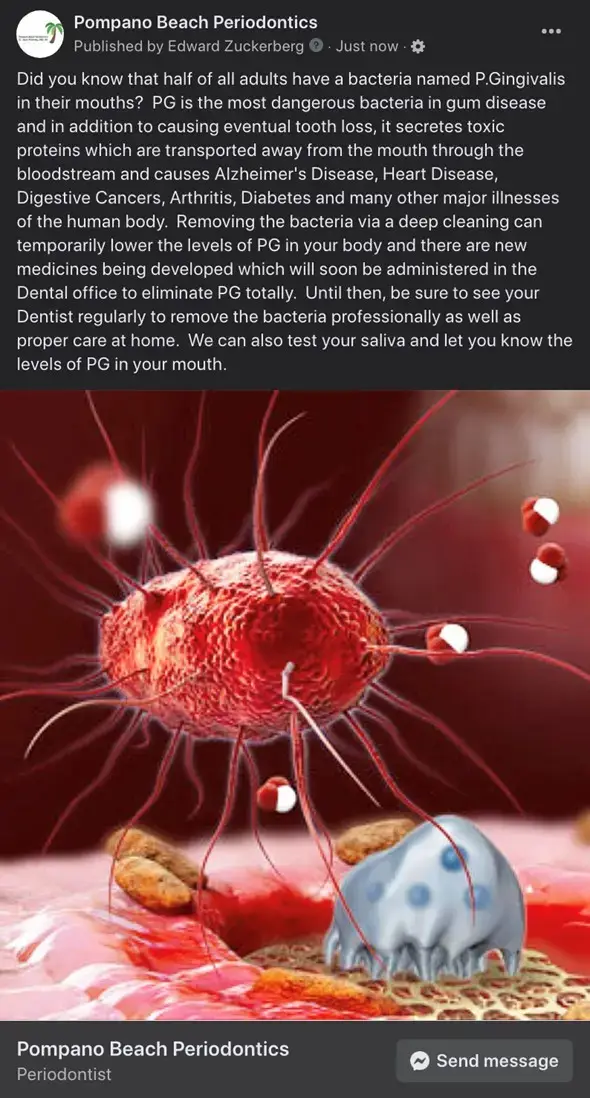
As you can see from the analytic results of the campaign completed here, the office can maximize the efficiency of their ad dollars and still target their biggest audience by changing the age demographic of the campaign from everyone 13+ to only 55+ or perhaps 45+
By effecting this demographic change, reach will be similar but by only reaching an audience of the specific age targeted you are more likely to reach folks interested in your message.
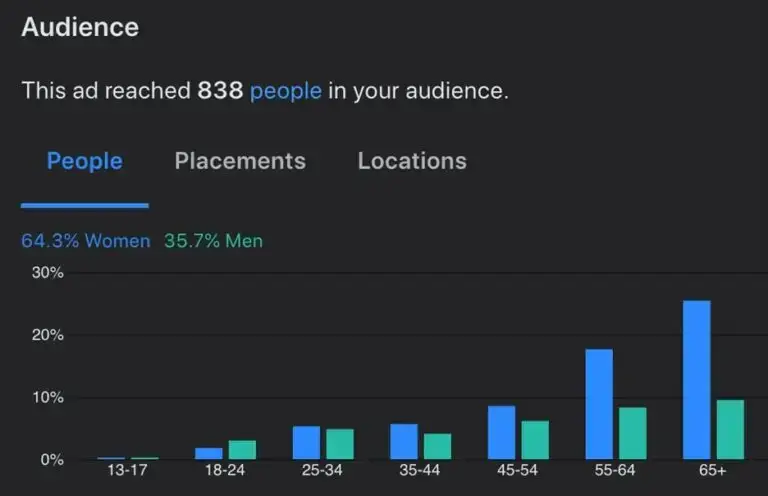
One last opportunity I’d like to mention here is that Keystone Bio recognizes the need to partner with Dentists, Hygienists and Dental Industry KOLs to help promote awareness of the role of P.Gingivalis in the oral-systemic link. For additional ways to participate in this exciting new treatment modality, please contact me at my Facebook Page www.facebook.com/painlesssocialmedia or via email at drz@painlessdrz.com


